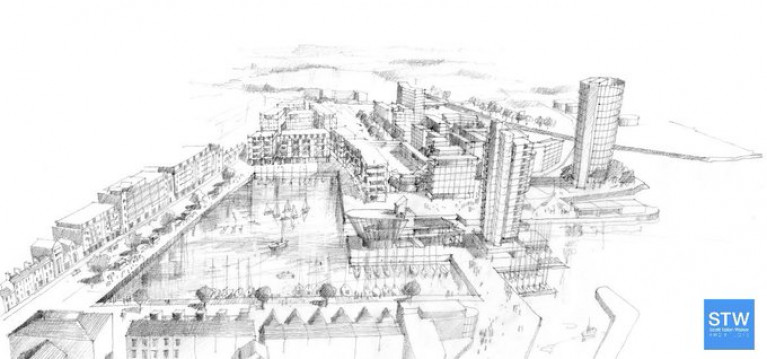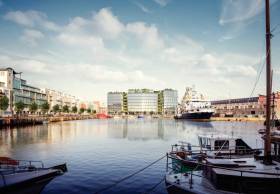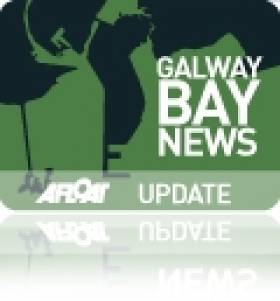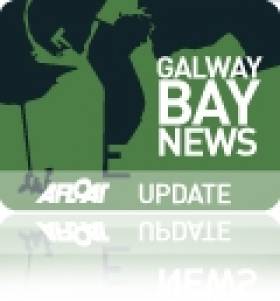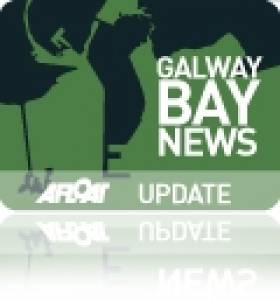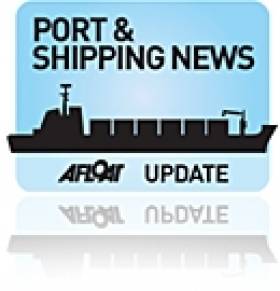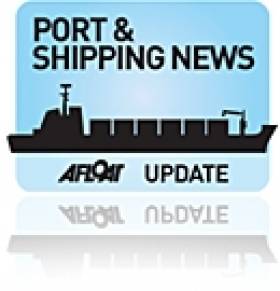Displaying items by tag: Dun Aengus Dock
Submissions numbering 200 in total, have been received from the public on plans for a major redevelopment of Galway Harbour.
The vision for the harbour would involve the transformation of 17 acres of land surrounding the inner port's dock area.
The plan sets out to deliver a sustainable urban living quarter with a key focus on public realm space.
Proposed public amenities include cross-city walking and cycling routes, cultural and event spaces, recreational water sport facilities and a re-imagined street network.
Galway Bay FM has more here
Galway Mayor Says Bonham Docks Development Would Represent Major Step Forward for City
#WaterfrontProperty - Mayor of Galway councillor Pearce Flannery, says the proposed €100 million development at the Docks would be a major step forward for the city.
His observation writes Galway Bay FM, was made at day two of the oral hearing concerning thedevelopment which would create a 26 thousand square metre office complex and public square in the heart of the city.
The building of the complex across Dock Road, Queen Street and Bothar na Long is led by Gerry Barret’s company Edward Capital.
Mayor Flannery told the hearing the Bonham Quay development provides an opportunity to energise the city, bringing vibrancy and new life into Galway.
He said the city has lost big firms such as AirBnB and LinkedIn to Dublin, while other cities have forged ahead because Galway has been constrained with development.
He stressed the plan is not about a building but about people, adding that the project would attract high-volume jobs into the area.
For more on the development story, click here.
Historic Cargo Delivered for Galway’s Grand Finale
#VESSEL VOLVO VILLAGE – Following yesterday's historic arrival of the Deo Volente, the first container ship to be unloaded in Galway Harbour which took six hours to complete concluded the delivery of logistics for the Volvo Ocean Race Grand Finale, writes Jehan Ashmore.
The cargo of containers packed with the spectator stand for the prestigious events 'Pop-Up' Village had travelled from Lisbon. But before any of this could be done the heavy-lift cargoship had to enter through the Galway's port dock gates. This was followed with the vessel making manoeuvres in the confines of the tidal basin of Dun Aengus Dock. It was a tight squeeze as the 105m long vessel edged closer to the berth in the basin which was witnessed by onlookers lining the quays.
The vessels cargo was almost the entire race village which is a travelling show that traverses the globe as part of the Volvo Ocean Race 2011-2012. It provided a "new challenge for Galway Harbour in handling containers" said Harbour Master Captain Brian Sheridan and I am delighted that the operation went better than anticipated.
After overnighting in the port, Deo Volente sailed this morning en-route to Rotterdam to pick up a cargo bound for the St. Lawrence Seaway. Currently the vessel is underway off the south-west coast.
Plans for New Galway Port Will Have to be Withdrawn
#GALWAY HARBOUR- A proposed €200m outer deepwater port will have to be withdrawn due to a failure by Galway Harbour Company to secure necessary approvals for preliminary investigations, according to a report in yesterday's Irish Times.
The ambitious plan, which intended to build following the success of the stopover of the Volvo Ocean Race in 2009 (and to return next July), was due to have been submitted directly to the planning appeals board some months ago under the Strategic Infrastructure Act.
However, the harbour company was advised that site investigation works for the application were conducted without first securing full approval for a foreshore licence from the Department of the Environment.
Taoiseach Enda Kenny is said to have been informed of the setback, which is expected to delay submission of a planning application to An Bord Pleanála until the mid-2012.
The development proposed transferring port operations outside from the existing single-dock facility (click HERE) south into Galway Bay, where reclaimed land in deeper waters would accommodate larger cruise-ships (click HERE) in addition a freight rail-link and a 200-berth marina.
Three’s A Crowd as Naval, Research and Cargo Ships Dock In Galway
Also sharing the basin but located closer to the dock gates was Arklow Shipping Ltd's Dutch registered dry-cargo vessel Arklow Surf (2000/2,316grt). The dock is capable of handling more vessels simultaneously and of course used as a host-port of the high-profile Volvo Ocean Race which is due to return next year.
Galway and neighbouring Limerick City with its Ted Russell Dock, are the only dock-gate accessed ports on the island of Ireland. In the case of Galway there is an exception as freight operations are also available from an outer pier on the seaward side of Dún Aengus Dock though only for domestic purposes. From this pier the dedicated Aran Islands freight service is operated by Lasta Mara TEO's Blath na Mara (1983/330grt). As for Limerick, vessels can also berth outside the dock but they tend to be small port-work related craft that use the outer berth on the Shannon Estuary.
The Galway Harbour Company in recent years have proposed plans for a new outer port, to be built in four stages with a completion date set for 2017. This would enable larger deeper drafted vessels such as tankers and cruiseships to dock in the new port. In the meantime cruiseships anchor off Mutton Island. In addition a freight rail-link, berthing for an inshore fishing fleet and a 216 berth marina are proposed.
To read more about the port proposals visit http://www.galwayharbour.com/news.php?id=11and for aerial visual impressions click HERE.
- River Shannon
- Marine Institute
- naval service
- Ports and Shipping
- Arklow Shipping Ltd
- Ports and Shipping News
- Aran Islands
- Island News
- Galway Bay News
- Marine Science News
- Dun Aengus Dock
- Galway Harbour Company
- Cruise Liner news
- Cruise ships
- Galway Harbour and Bay news
- Ted Russell Dock
- Marine Instistute Research vessels
- Lasta Mara TEO
Galwegian Special Olympian Athletes Celebrate On board Navy's Flagship
The world games which were held during June and July saw over 7,500 athletes from 185 countries participate in the Greek capital. Team Ireland in total brought home 107 medals, with athletes from Galway securing 11 medals and a number of ribbons in a variety of sports.
Speaking about the reception, Regional Director Myra Merrick said: "We are honoured to have the Naval Service docking in Galway especially for the function. The athletes deserve a warm reception and recognition for their wonderful success. It's a huge achievement in itself to participate at World Games level, let alone bring back a medal".
"The event presents an exceptional opportunity for the public to extend congratulations to our local sporting heroes, explore the Defence Forces vessel and meet the officers" she added.
The 1984 built /1,910 tonnes 'helicopter patrol vessel' and her seven fleetmates are all each assigned to a particular charity. In the case of L.E. Eithne she is associated with Our Lady's for Sick Children, Crumlin in Dublin.
Mauritius-Bound Ferries Finally Bid Galway Farewell
First to be loaded was the Clann na nOileáin on Wednesday in an operation than took four-hours while on Friday her sister Clann Eagle I took six-hours to be winched safely onto the cargo-deck during freshening winds.
It is ironic that since Thor Gitta 's arrival to the port's Dún Aengus Dock on 5 April that it would also nearly be the same time taken for the estimated 25-day delivery voyage of the ferries to the Indian Ocean island.
During the 8,300 mile journey Thor Gitta will make several port of calls with the first call to La Rochelle. The Bay of Biscay port is the next largest port south of Les Sables d'Olonnes, where the fast-ferries where built at the OCEA boatyard for her original owners Bád Arann Teoranta which traded as Aran Direct on routes from Rossaveal to the islands.
Thor Gitta was built in 1996 and is also designed to carry 364 TEU (twenty-foot equivilant unit) containers and belongs to an-eight strong fleet operated by the Danish company, Thor Rederi A/S of Svendborg.
One of the reasons why the heavylift vessel was delayed in loading was to ensure the correct positioning of the ferries so not to further disrupt other port call cargo allocation while on the long repositioning voyage to Mauritius.
The 4,078 tonnes cargsoship is also scheduled to make en-route calls to Pointe Noir in the Congo, Cape Town and Pemba in Mozambique before finally reaching the southern Indian Ocean destination.
When the ferries were completed in 2005 and 2006 they were valued between €5-6m but they only served up to September 2008 when the 243 passenger aluminium built craft were laid-up at the Connemara harbour due to financial difficulities.
This led to the company going into receivership and the vessels were put up for auction in Galway last February. Despite bids reaching €950,000, they were withdrawn at the auction hosted by the Cork based auctioneer, Dominic J. Daly.
In the following month the fast-ferries were sold to the French owner for a new career based from the island state which is in the Mascarene Islands. Mauritius is neighboured by the smaller islands of Agalega, Cargados Carajos, Rodrigues and the French island of Réunion some 200km to the southwest.
Ongoing Ferry Saga As Cargoship is Detained
Harbourmaster Capt. Brian Sheridan, confirmed yesterday evening that the Danish flagged vessel had been detained at lunchtime on the instructions of the admiralty marshal, a High Court judge, acting under maritime law. Until matters are resolved, a ship's keeper has been placed onboard by the Revenue Commissioners.
Cargoship to Attempt Second Ferry-Lift
In the first attempt to load the ferries last week, the Clann na nOileáin fell into the Dun Aengus Dock when the sling rope broke causing the French built 234-passenger craft to fall some 12m /40ft. Onboard the ferry were three people who were taken to hospital but were later released.
Thor Gitta is fitted with two deck-mounted cranes and this feature is also similarly found on the Patanal, which grounded in Casla Bay at the entrance to Rossaveal, nearly a fortnight ago. The German owned 7,002grt was the first vessel chartered to bring the fast-ferries from Rossaveal, but the ferries were subsequently sailed to Galway after the ship was refloated.
The 120m Patanal has undergone "underwater and internal inspections and repairs," according to Capt. Brian Sheridan, harbourmaster of Galway Port Company though he added "that the vessel would remain subject to an inspection by the Marine Survey Office before she can be released".
According to a statement released by the Patanal's owners, Harren & Partner, the vessel is then to be taken to dry dock in Bremerhaven for further repairs.
Since the incident the vessel has been at anchorage off Black Point on the Co. Clare side of Galway Bay where she was monitored initially for pollution and the tug Celtic Isle in attendance. The tug is operated by Celtic Tugs and is normally based in Foynes, Co. Limerick.


























